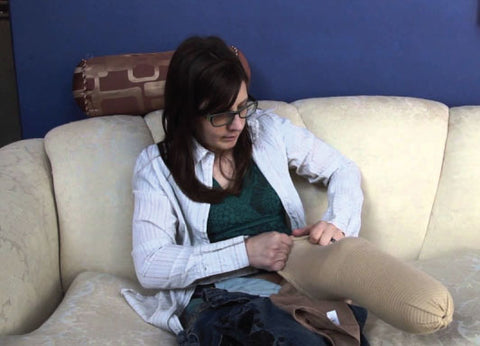How Compression Shrinker Socks Help Maintain a Good Socket Fit
Amputees are all too familiar with a prosthetic shrinker because they are sure to wear them at one point or another. They usually are introduced to the shrinker during their rehabilitation phase when limb maturation and swelling reduction are critical. Some continue to use it after that, and others choose to end their short-lived relationship with the shrinker then and there.

(photo courtesy of @amputeeot)
The shrinker is what many also call a compression sock. Its primary function is to control the volume of your residual limb, keeping it within a specific size range. Going through a long day wearing a prosthesis leads to muscle soreness, fluid build-up, and swelling. Wearing the shrinker at night helps reduce all of that, maintain socket fit for the morning, which makes compression shrinkers a helpful addition to your nightly routine.Prosthetic Shrinkers as double agents
Thanks to fiber technology, we now have prosthetic shrinkers that are composed of fibers that promote the inhibition of bacterial growth and control temperature. Shrinkers are socks that prevent and control swelling, exhibit healing, and ultimately shape the amputated limb.
Since prosthetic shrinkers are most useful in reducing swelling, it is best to wear them when you're not using your prosthesis. Doing so will help in maintaining a consistent and perfect fit of your prosthesis.
More benefits of compression socks for amputees
Shrinkers help promote blood flow. Since our veins are not structured with muscles unlike arteries, it's harder for the blood to flow smoothly via veins as they have to battle against the force of gravity to make it to the heart.Ideally, the contraction of leg muscles during walking will promote vein blood flow by tightening around them. This implies that anything that inhibits this flow, may it be lack of movement or even amputation, will ultimately result in blood build up in the veins and tissue of the residual limb.
Consequently, prosthetic shrinkers compress the residual limb and act the way the muscles do during contraction. Compression of the residual limb also promotes the lymph in your limb. Lymph is essential in reducing tissue swelling. All these swelling reductions also reduce any discomfort on the residual limb itself, which are caused by the squeezed nerves surrounding the limb.
What type of compression is best for you?
As for shrinker compression, it will all depend upon your prosthetist or physician. Otherwise, most amputees are advised to have standard compressions of 20 to 30 mmHg. Anything that goes higher will be too tight and puts the user at risk of harm or further injury.Also, make sure that you replace your shrinkers every four to five months. Wearing a pair beyond that will make it lose its elasticity, and a loose shrinker is a useless one.










































































